
This online exhibition is a tribute to Ang Lee’s 1995 film Sense & Sensibility based on Jane Austen’s classic novel published in 1811. As a fan of period dramas and being fascinated by the film-making process, I have been particularly interested in the screen adaptation of Sense & Sensibility. Emma Thompson’s script is intricate, witty and dense, elucidating Austen’s narrative and making it accessible to a contemporary audience. It’s a story about divisions (class, gender and urban v. rural) as much as one about love, loss and separation. Ang Lee’s film is a sensitive but lush production featuring a complex set of locations finely embedded into the narrative fabric.
Ever since watching S&S back in March 1996 – and especially after reading Emma Thompson’s “Screenplay & Diaries” – I wanted to visit as many of the filming locations as possible in order to retrace the steps of the production team and revisit the script. This online exhibition features 42 photographs – selected from hundreds taken over three periods of ‘scouting’ between August 2008 and October 2012 across Devon, Wiltshire, Somerset and London. A list of all locations visited along with links to their websites is included below.
When curating the images for this exhibition, I have tried to weave together three narratives – passages from Emma Thompson’s screenplay for Sense and Sensibility; my original photos corresponding to those passages, along with details of the filming locations (obtained from their respective booklets and souvenir guides); as well as trivia about the filming of S&S (drawing from Thompson’s published Diaries of S&S) and notes and trivia from my own journey. This involved watching the film frame-by-frame and, where possible, matching each photo to the corresponding dialogue, scene or point-of-view (POV). I have divided the photo-essay in chapters which are named after the corresponding tracks of the film’s brilliant original soundtrack by Patrick Doyle.
It goes without saying that this is only a small collection of photos and passages from the film and it is not, by any means, an exhaustive list of the locations used or a meaningful account of the narrative itself. While every effort has been made to identify and capture all of main filming locations, two of them were not accessible at the time of ‘scouting’: Efford House on the Flete Estate in South Devon, which became Barton Cottage – the small cottage to which the Dashwood ladies move after the death of Mr Dashwood – could not be accessed, although it is available to rent as a holiday cottage; similarly, the very handsome Trafalgar Park near Salisbury in Wiltshire (which became Barton Park – the country home of the lovely albeit slightly overwhelming Sir John Middleton and his mother-in-law Mrs Jennings) is only available for filming, corporate parties and weddings.
A note on the numbering of scenes: the selected slug lines follow the published screenplay, although several scenes were omitted in the final cut and tweaks made to the text. Where there is a difference between the published script and the filmed dialogue, the latter was transcribed. All passages from the script included in this exhibition are reproduced under the terms of fair use, strictly for non-commercial purposes.
INT = Interior shot
EXT = Exterior shot
1. A Particular Sum
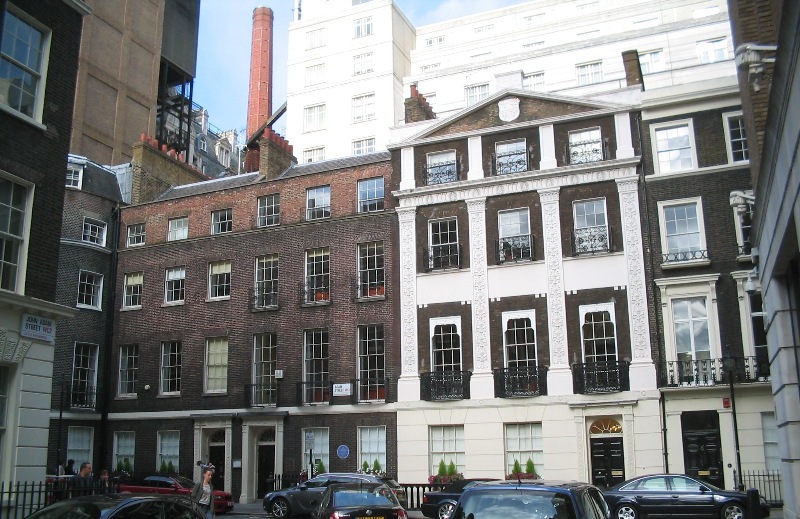
John and Fanny’s Town House: Adam House, 7 Adam Street, London WC2. Comparing this photo with the filmed scene gives us two fascinating insights: a) how a busy urban landscape at the turn of the 21st century compares with the exact same one in 1792 and b) the interventions and changes needed during the film-making process to achieve this (e.g. eliminating street signs, fire alarm boxes, blue plaques and adding lots of curtains!).
3 EXT. JOHN AND FANNY’S TOWN HOUSE. LONDON. DAY.
Outside the house sits a very well-to-do carriage. Behind it waits another open carriage upon which servants are laying trunks and boxes.
FANNY (V/O): Help them? What do you mean, ‘help them’?
4 EXT. JOHN AND FANNY’S TOWN HOUSE. DRESSING ROOM. DAY.
JOHN: Dearest, I mean to give them three thousand pounds.
11 EXT. NORLAND PARK. DRIVE. DAY.
JOHN and FANNY’s carriage approaches Norland.
FANNY (V/O): They will be much more able to give you something.
2. My Father’s Favorite
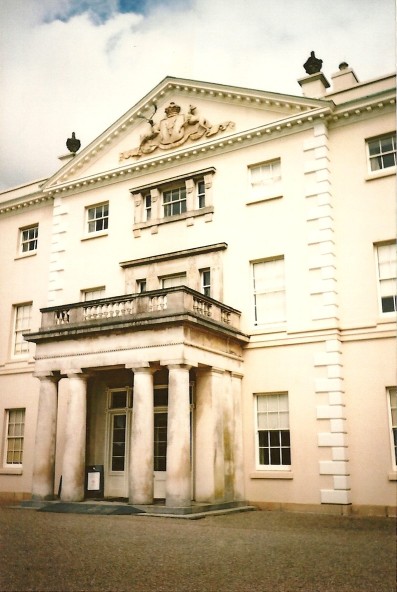
Norland Park: Saltram House, Plympton, near Plymouth in Devon. Saltram is a George II era mansion built by the Parker family in the 1740s – and the Parkers’ home for 300 years. It is today owned by the National Trust and is open to the public.
19 EXT. NORLAND PARK. DRIVE. DAY.
A very capable HORSEMAN (EDWARD FERRARS) canters up the gravel drive. CLOSE on his face as he gazes up at the elegant façade.
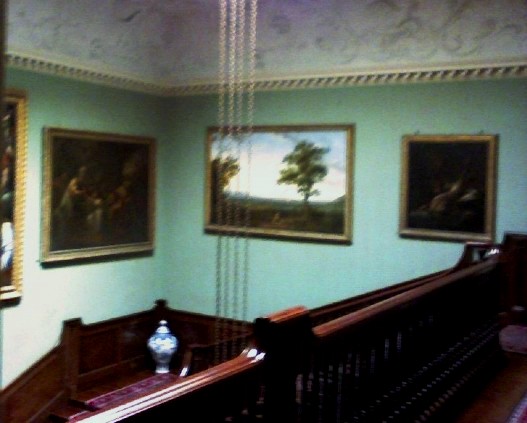
The staircase at Saltram House, Devon. Taking good photos inside Saltram is all but impossible so this image of the staircase was the only one I managed to produce. Interestingly, the colour of the wallpaper both in this photo (taken in 2008) and in the National Trust’s postcards is green, whereas in the film it appears to have a blue/lilac hue. In her diaries, Emma Thompson describes how protective National Trust staff and volunteers were of their historic properties, and the tensions posed by the mere presence of a crew of 120 people with heavy cameras and equipment.
21 INT. NORLAND PARK. STAIRCASE. DAY.
FANNY is walking with EDWARD, who looks at the pictures with interest.
FANNY: They are all exceedingly spoilt, I find. Miss Margaret spends all her time up trees and under furniture and I have barely had a civil word from Marianne.
EDWARD: My dear Fanny, they have just lost their father – their lives will never be the same again.
FANNY: That is no excuse.
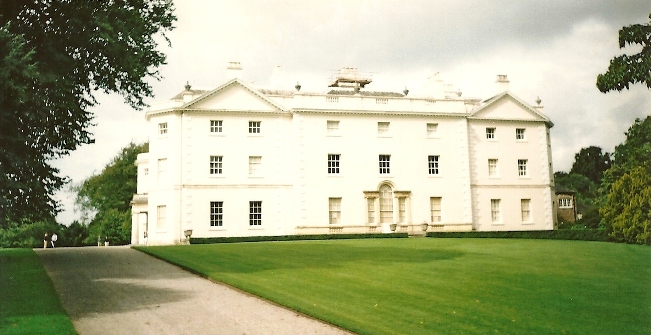
Norland Park– a.k.a. Saltram House. Saltram is famous for its Robert Adam interiors, such as the Great Drawing Room and the Staircase Hall, which are considered amongst the best that he ever designed.
28 EXT. NORLAND PARK. GARDENS. DAY.
EDWARD and ELINOR are still talking as they walk arm in arm in the late-afternoon sun.
EDWARD: All I want – all I have ever wanted – is the quiet of a private life but my mother is determined to see me distinguished.
ELINOR: As?
EDWARD: Anything – a great orator, a leading politician… I think even a barrister would serve, as long as I drove a barouche and dined in the first circles.
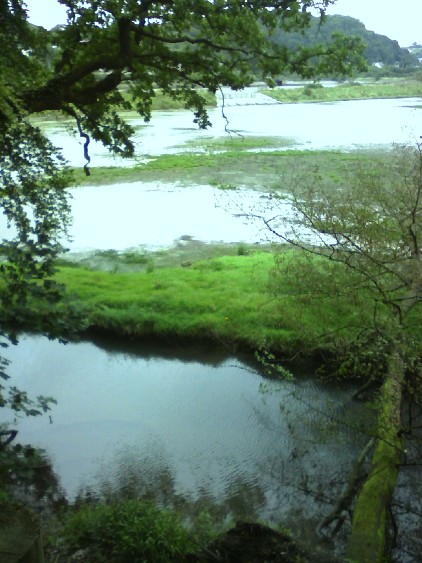
The Plym Estuary at Saltram Park. This is where Elinor (Emma Thompson) and Edward (Hugh Grant) ride the horses.
30 EXT. FIELDS NEAR NORLAND. DAY.
EDWARD and ELINOR are on horseback. The atmosphere is intimate, the quality of the conversation rooted now in their affections.
ELINOR: You talk of feeling idle and useless – imagine how that is compounded when one has no choice and no hope whatsoever of any occupation.
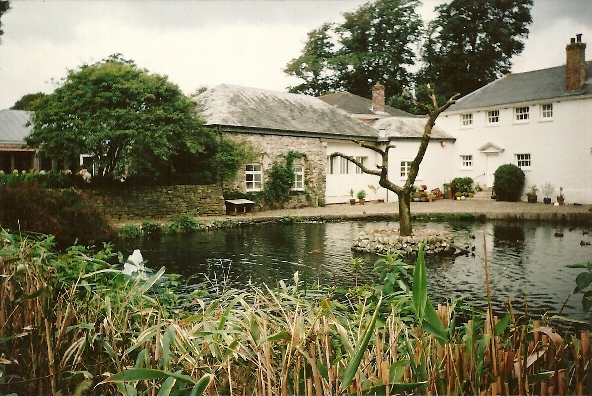
The Stables at Saltram where Edward attempts to speak to Elinor about his situation before being interrupted by Fanny who dispatches him to London.
37 INT/EXT. NORLAND PARK. STABLES. DAY.
ELINOR has come to say goodbye to her HORSE. She strokes the soft face sadly. Then she senses someone and turns to find EDWARD standing nearby.
EDWARD: Miss Dashwood – Elinor. I must talk to you.
The use of her Christian name – and in such a loving tone – stops ELINOR’s breath altogether.
EDWARD: There is something of great importance I need… to tell you-
3. Devonshire
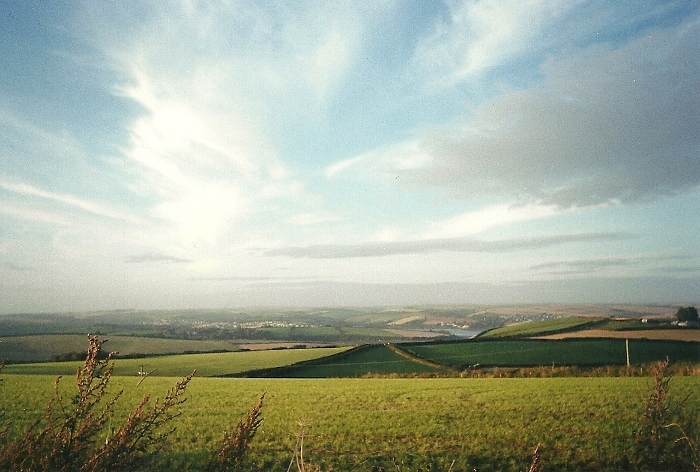
The beautiful landscape of South Devon near Kingsbridge and Salcombe, only a few miles away from the Flete Estate (Barton Cottage), home to the Dashwoods. The scenes at Barton Park – the main estate house of Sir John (Robert Hardy) and Mrs Jennings (Elizabeth Spriggs) – were filmed in Wiltshire, although the action is supposed to take place in Devon.
58 INT. BARTON COTTAGE. PARLOUR. LATE AFTERNOON.
MRS DASHWOOD: But he loves you, dearest, of that I am certain.
ELINOR looks down. She speaks slowly, choosing her words with care.
ELINOR: I am by no means assured of his regard to me. But even were he to feel such a… preference, I think we should be foolish to assume that there would not be many obstacles to his marrying a woman of no rank who cannot afford to buy sugar…
MRS DASHWOOD: But Elinor – your heart must tell you –
ELINOR: In such a situation, Mamma, it is perhaps better to use one’s head.
74 EXT. BARTON COTTAGE. GARDEN PATH. DAY.
COLONEL BRANDON: She is wholly unspoilt.
ELINOR: Rather too unspoilt, in my view. The sooner she becomes acquainted with the ways of the world, the better.
COLONEL BRANDON: I knew a lady like your sister – the same impulsive sweetness of temper – who was forced into, as you put it, a better acquaintance with the world. The result was only ruination and despair. Do not desire it, Miss Dashwood.
4. All The Delights of The Season
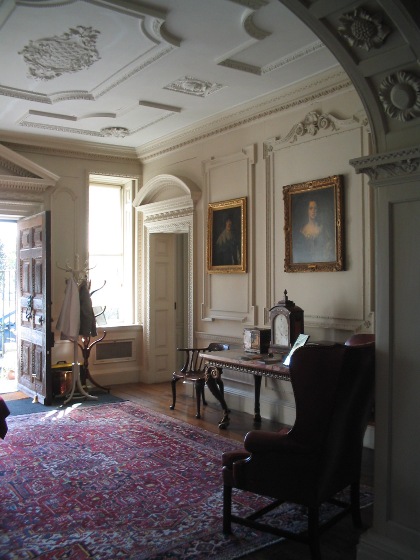
The Entrance Hall of Mompesson House, which provided the location for the majority of the rooms of Mrs Jennings’s London house. Mompesson is situated in the Cathedral Close in Salisbury, Wiltshire. It was rebuilt in 1701 for Charles Mompesson, a lawyer and local MP. It is now owned by the National Trust and is open to the public.
99 INT. MRS JENNINGS’S HOUSE. HALL. DAY.
They enter the grand hallway under the supercilious gaze of a powdered FOOTMAN (MR PIGEON). ELINOR is haggard after two days of close proximity with LUCY. MRS JENNINGS is all officious bustle and MARIANNE is feverish with anticipation. She whispers to MRS JENNINGS, who laughs heartily.
99 CONT’D
LUCY: A letter! So they are definitely engaged! Mrs Jennings says your sister will buy her wedding clothes here in town.
ELINOR: Indeed! Miss Steele, I know of no such plan.
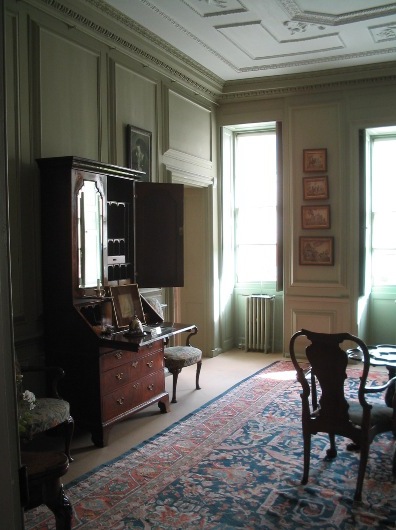
The Drawing Room of Mrs Jennings’s House (in reality the Green Room at Mompesson House) where Marianne (Kate Winslet) impatiently waits for a letter from Willoughby (Greg Wise) and where Brandon (Alan Rickman) has his final hopes dashed. While the radiators have been covered with wooden boards, few other changes can be seen and even the set of chairs in this photo features in the scene.
100 INT. MRS JENNINGS’S HOUSE. DRAWING ROOM. DAY.
ELINOR: Colonel, though neither one has informed me of their understanding, I have no doubt of their mutual affection.
BRANDON stands very still.
COLONEL BRANDON: Thank you, Miss Dashwood. To your sister I wish all imaginable happiness. To Mr Willoughby, that he… may endeavour to deserve her.
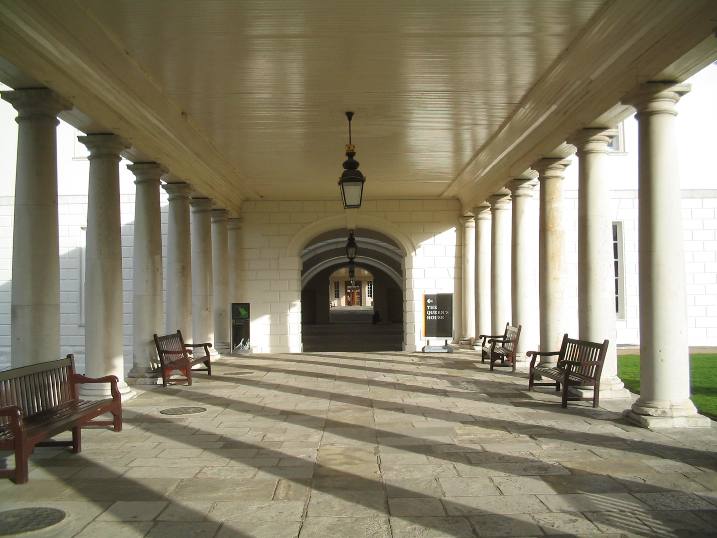
The Colonnade at the Queen’s House in Greenwich served as the busy market through which the Palmers, Mrs Jennings, John, Fanny, Lucy, Elinor and Marianne walk.
101 EXT. GREENWHICH ARCADE. LONDON. DAY.
MRS JENNINGS: And who is ‘dear Edward’?
CHARLOTTE: Who indeed?
FANNY smiles glacially.
FANNY: My brother, Mrs Jennings – Edward Ferrars.
MRS JENNINGS looks at ELINOR in sly triumph.
MRS JENNINGS: Indeed! Is that Ferrars with an F?
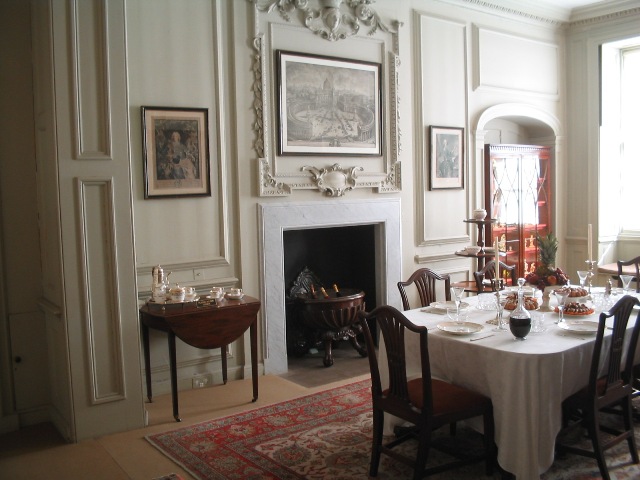
The Dining Room at Mompesson House serving as Mrs Jennings’s Morning Room. The mahogany dining table and chairs are Hepplewhite (c. 1770) and feature in the film in scene 105.
105 INT. MRS JENNINGS’ HOUSE. HALL. MORNING.
MRS JENNINGS is giving PIGEON his instructions for the day. MARIANNE comes running downstairs. PIGEON regards her drily.
PIGEON: No messages, ma’am.
5. Willoughby
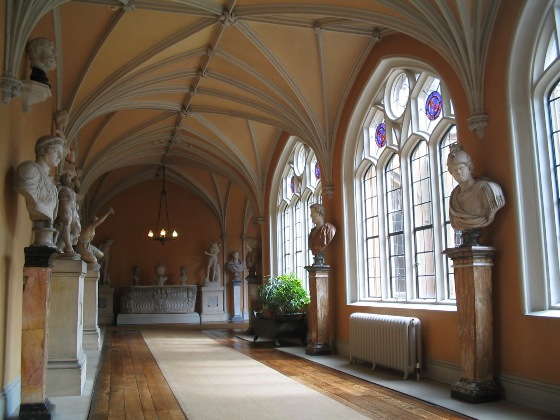
The Upper Cloisters at Wilton. The stained glass in the upper parts of the windows dates from the 1570s. The ballroom scene required 5 days of overnight filming at Wilton
107 INT. GRAND BALLROOM. EVE.
The great ballroom is crammed with GUESTS all determined to enjoy themselves despite the considerable inconveniences caused by noise, heat and overcrowding. […]
WILLOUGHBY is shamed into silence. Then he sees MARIANNE. At the same moment the music pauses. MARIANNE looks up. In the brief moment of relative quiet, her great cry rings across the room.
MARIANNE: Willoughby!
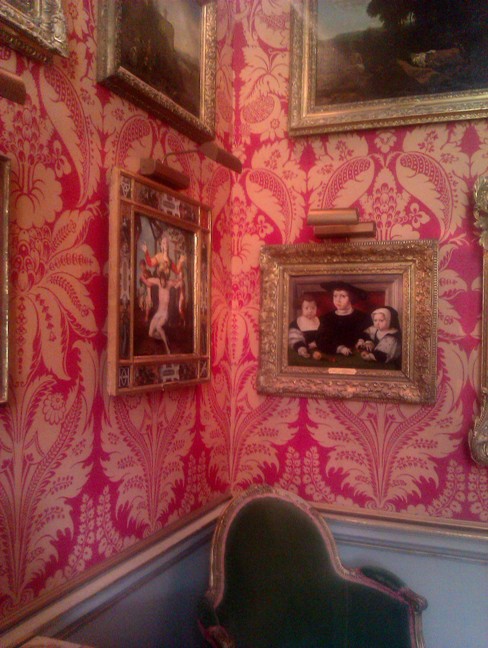
The King’s Closet (the Little Ante Room) at Wilton decorated with Pavia pattern wallpaper. Jan Gossaert’s ‘Children of Christian II of Denmark’ can be seen above the George III armchair. This room is part of Wilton’s State Apartment – a set of six rooms designed by Inigo Jones and John Webb in the 17th century to host the King, redecorated and furnished by Catherine Woronzow in the 1820s – at which the dance / Marianne-meets-Willoughby scene was filmed. The most famous and magnificent of the six rooms – the Single Cube Room and the Double Cube Room – constitute the epicentre of the scene. Wilton is one of the most magnificent English mansions I’ve ever seen and the Double Cube Room alone is worth the visit.
110 INT. MRS JENNINGS’S HOUSE. BEDROOM. DAY.
ELINOR finds MARIANNE sitting on the edge of the bed. She does not acknowledge ELINOR but merely lifts the letter and reads out, with deadly calm…
6. Excellent Notion
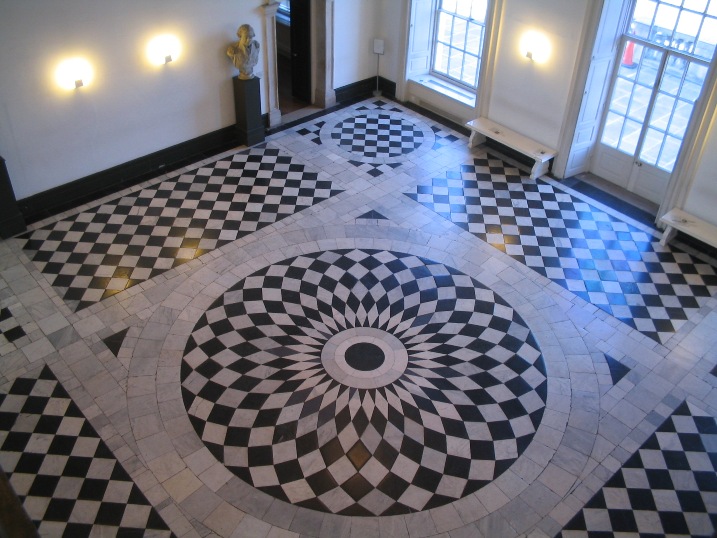
The Great Hall at the Queen’s House (National Maritime Museum, Greenwich) was used as the location for the Covent Garden coffee house (Scene 111) where Fanny (Harriet Walter), John (James Fleet) and Robert (Richard Lumsden) are drinking chocolate. The Queen’s House, designed by Inigo Jones and finished in 1638, is considered as England’s first classical building.
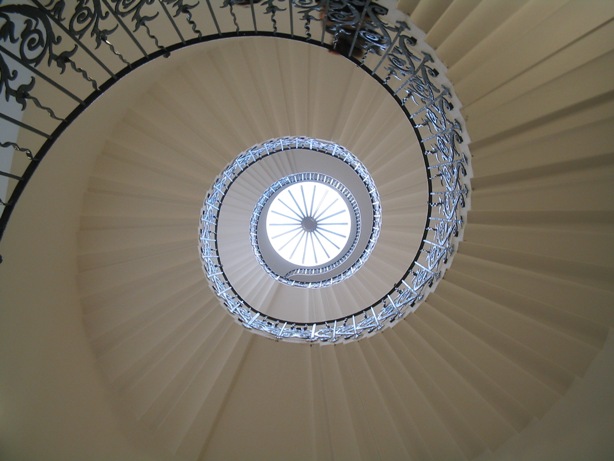
Inigo Jones’s breathtakingly beautiful Tulip Staircase – situated directly next to the Great Hall at the Queen’s House.
111 INT. COFFEE-HOUSE. COVENT GARDEN. DAY
FANNY, JOHN and ROBERT are drinking chocolate together.
ROBERT: Apparently they were never engaged.
FANNY: Miss Grey has fifty thousand pounds. Marianne is virtually penniless.
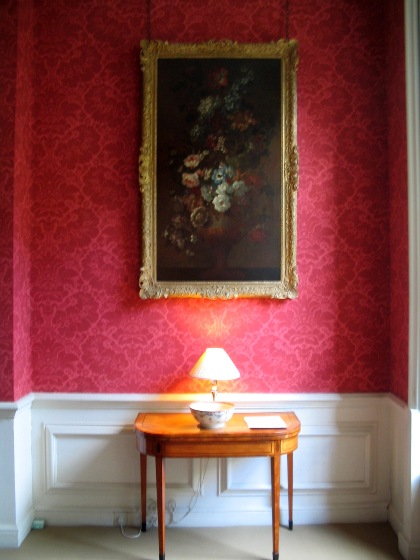
The Large Drawing Room at Mompesson House features as the Drawing Room at Mrs Jennings’s House as Colonel Brandon (Alan Rickman) finally speaks to Elinor. The room was created in the 1740s by Charles Longueville and redecorated in 1995 (presumably just before filming) with the red wallpaper, copied from a 1760s-pattern damask. The Dutch flower painting shown here and in the film is from the Robert S. Watney collection.
114 INT. MRS JENNINGS’S HOUSE. DRAWING ROOM. DAY.
ELINOR is seated at a desk writing a letter. There is a sudden rap at the front door. Footsteps are heard and as she turns, the maid enters with COLONEL BRANDON. ELINOR rises to greet him. […]
COLONEL BRANDON: I would not have burdened you, Miss Dashwood, had I not from my heart believed it might, in time, lessen your sister’s regrets.
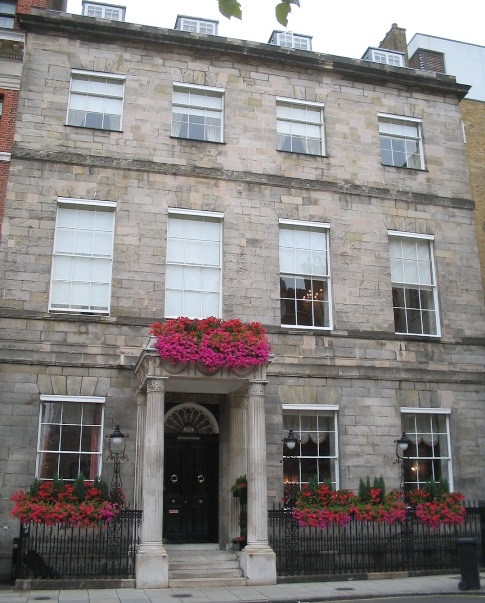
Chandos House at 2 Queen Anne Street, London W1, near Wigmore Street and just behind the BBC’s Broadcasting House. Chandos House, a Grade I listed building designed by Robert Adam and owned by the Royal Society of Medicine, served as the Palmer Residence in London.
124 EXT. PALMER RESIDENCE. LONDON STREET. DAY.
LUCY and MRS JENNINGS are on the doorstep. LUCY looks rather lost and pathetic, with her little bundles, hastily packed. The door opens and CHARLOTTE precedes the SERVANT, ushering them in with shrill cries of sympathy.
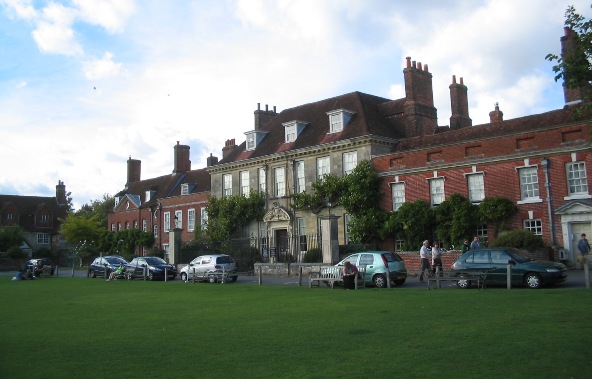
Salisbury’s Cathedral Close with Mompesson House at the centre. This is where Elinor and Colonel Brandon take a stroll shortly before leaving London. Brandon asks Elinor to tell Edward of a proposition that would make his (Edward’s) marriage to Lucy possible. Naturally, Elinor – being herself in love with Edward – is reluctant to do that.
125 EXT. SQUARE IN FRONT OF MRS JENNINGS’S HOUSE. LONDON. DAY.
ELINOR and BRANDON walk round the quiet square.
7. Leaving London
127 EXT. MRS JENNINGS’S HOUSE. DAY.
The PALMERS’ carriage stands outside the house. COLONEL BRANDON helps MARRIANE in beside ELINOR before mounting his horse to ride alongside. MRS JENNINGS waves goodbye from the steps. The carriage moves off.
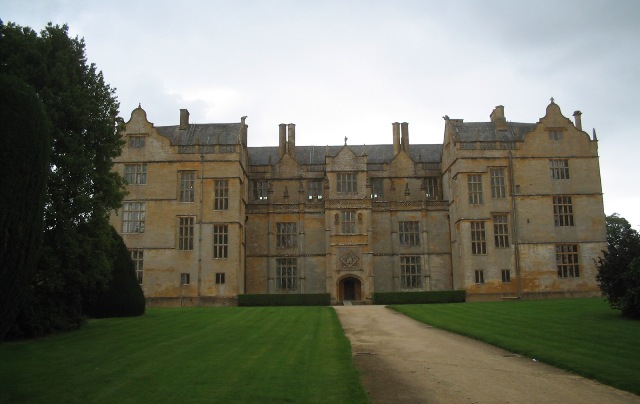
Montacute House, Yeovil, Somerset which features in the film as the Palmers’ country residence, Cleveland. Montacute was built for Sir Edward Phelips – a lawyer and parliamentarian who eventually went on to prosecute Guy Fawkes – in the late 16th century. It combines England’s Gothic tradition with up-and-coming Renaissance elements from continental Europe. For a short time in the early 20th century Montacute was owned by Lord Curzon and after he put it up for sale it was saved by Ernest Cook (grandson of Thomas Cook). Since 1931 it has been owned by the National Trust and is open to the public.
130 EXT. CLEVELAND. DRIVE. AFTERNOON.
The carriage stands outside the PALMER residence, a resplendent affair with a great deal of land. BRANDON is helping MARIANNE and ELINOR out of the carriage. […]
ELINOR: I think it is going to rain.
MARIANNE: No, no, it will not rain.
ELINOR cannot help but smile at this return of the old MARIANNE.
ELINOR: You always say that and then it always does.
MARIANNE: I will keep to the garden, near the house.
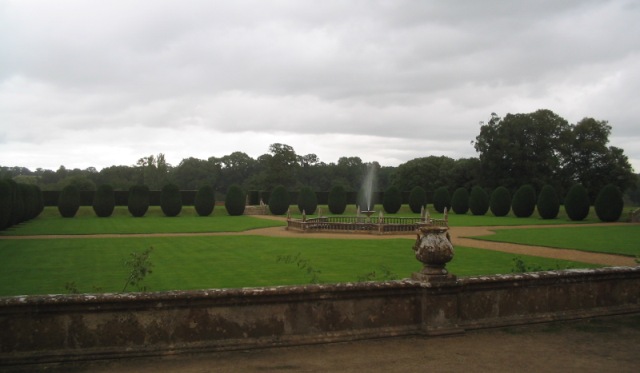
The garden at Montacute. As it starts to rain heavily, Marianne walks across the garden and decides to search for Combe Magna – Willoughby’s estate.
8. Combe Magna
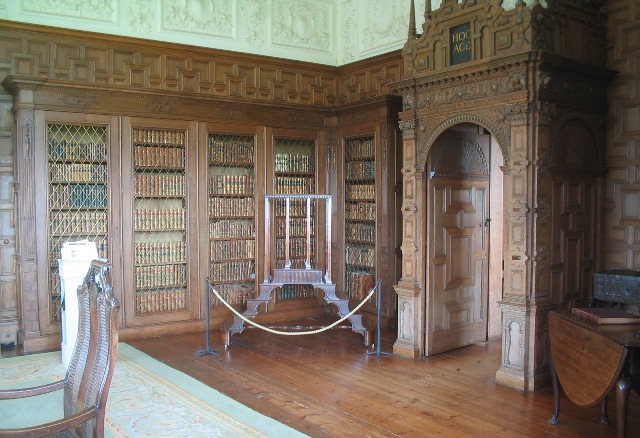
The Library at Montacute House, serving as the Drawing Room at Cleveland. The room features a grand chimneypiece with Corinthian columns flanking the grate. During the 17th century this was the formal dining-room of the house. This photo’s POV is almost identical to that in scene 132.
132 INT. CLEVELAND. DRAWING ROOM. DAY.
MRS BUNTING, a rather baleful NANNY, looks on as MR PALMER holds up a screaming BABY in a frilly bonnet for everyone’s inspection.
[…] BRANDON flicks a glance at MR PALMER for whom holding a baby comes as naturally as breathing underwater.
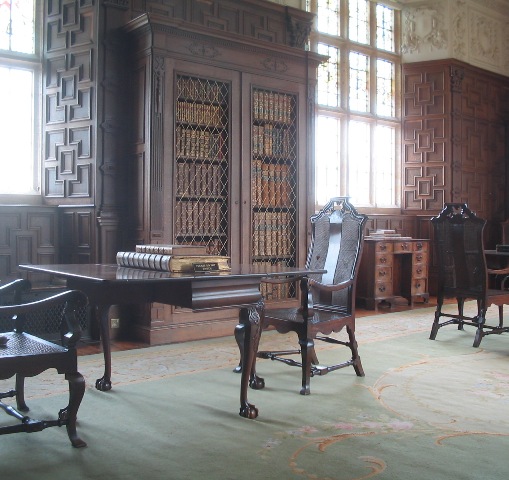
The other side of the Library at Montacute. Elinor goes up to that window to look for Marianne as she’s starting to get worried.
140 INT. CLEVELAND. DRAWING ROOM. DAY.
ELINOR turns from the window. BABY THOMAS stops crying for two seconds.
ELINOR: I cannot see Marianne.
143 EXT. THE HILL. DAY.
MARIANNE has reached the top. Soaked to the skin, she stands with the storm raging around her, staring at the spires of Combe Magna, the place that would have been her home. Rain streaks her face and the wind whips her hair about her.
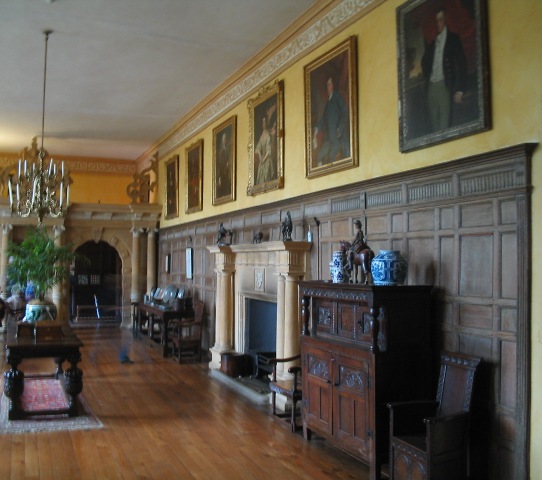
The Great Hall at Montacute House appearing as the Hall at Cleveland. As noted in the guide to the house, the purpose of this room was largely ceremonial – a place to greet guests and the starting point for the formal processing of food from the kitchen to the Dining Room (now the Library). The portraits lining the wall are of the Phelips family line.
150 INT. CLEVELAND. HALL. DAY.
Everyone rushes out of the drawing room as the COLONEL enters with MARIANNE. He is exhausted and soaked. MARIANNE is dumb with cold and fatigue.
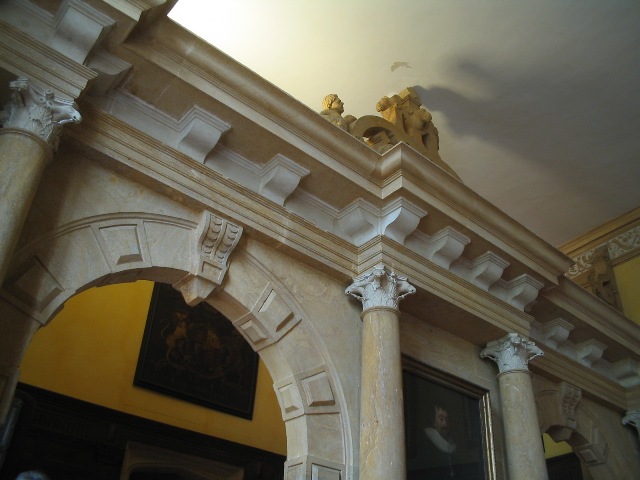
The Great Hall at Montacute – where a soaked Colonel Brandon (Alan Rickman) emerges carrying Marianne (Kate Winslet) who is unconscious, while the Palmers (Hugh Laurie and Imelda Staunton) and Elinor (Emma Thompson) approach him, carry Marianne off and leave Brandon exhausted in middle of the hall. As Emma Thompson notes in her Diaries (p. 254), this was a particularly dynamic and complex scene as Ang Lee wanted to do it all in one shot.
9. To Die For Love
159 EXT. CLEVELAND. DRIVE. EVE.
BRANDON mounts his horse, turns to look at the house for a moment, and then spurs it violently forward.
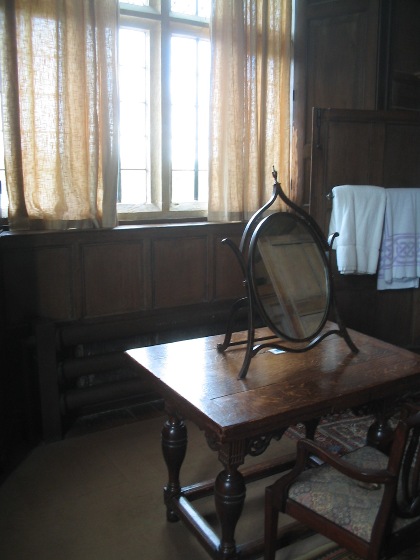
Lord Curzon’s Room at Montacute House, featuring as the bedroom used by Elinor and Marianne during their stay at Cleveland.
164 INT. CLEVELAND. ELINOR AND MARIANNE’S BEDROOM. LATER.
The room is very still. MARIANNE is pale as wax. DR HARRIS puts on his coat. ELINOR looks at him fearfully.
DR HARRIS: I must fetch more laudanum. I cannot pretend, Miss Dashwood, that your sister’s condition is not very serious. You must prepare yourself. I will return very shortly.
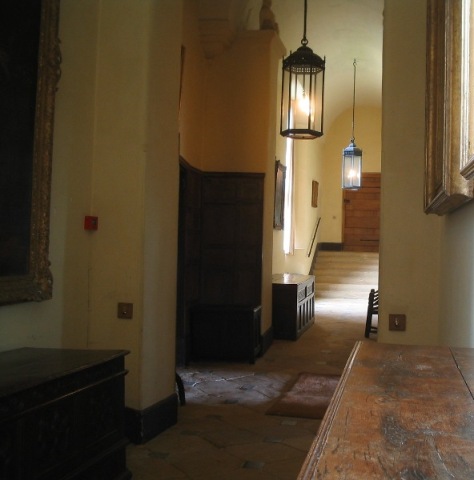
The Ground Floor Corridor at Montacute, across which Elinor runs to let her mother (Gemma Jones) know that Marianne is out of danger.
169 INT. CLEVELAND. STAIRCASE. MORNING.
ELINOR hurls herself down the stairs. She reaches the door just as BRANDON and MRS DASHWOOD enter and practically swoons into her mother’s arms.
10. Throw The Coins
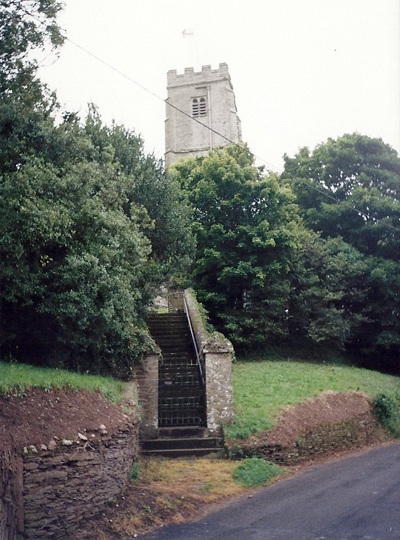
St Mary’s Church at Berry Pomeroy in the South Hams district of Devon, two miles east of Totnes. It features as the Barton Village Church in which Marianne and Colonel Brandon get married in the final scene.
191 EXT. BARTON VILLAGE CHURCH. DAY.
A large wedding party is gathered outside the church. The entire village is present – CHILDREN, FARMERS, LABOURERS, SHOPKEEPERS, and all our PRINCIPALS. […]
CAM pulls back as the wedding procession makes its glorious way from the church. We draw away into the surrounding countryside. Then we see, on the far edge of frame, very small, a MAN sitting on a white horse, watching. It is WILLOUGHBY. As we draw back further still, he slowly pulls the horse around and moves off in the opposite direction.
On Location
Revisiting Sense & Sensibility: An Online Exhibition
October 2012
All photos: August 2008 – October 2012 | © Roman Gerodimos
Exhibition poster: The Great Hall at the Queen’s House, London.
Fonts: Edwardian Script ITC, DCC Sharp Distress Black, New Press Eroded
Filming Locations:
Norland Park: Saltram House, Devon
Cleveland: Montacute House, Somerset
Mrs Jennings’s London House: Mompesson House, Wiltshire
Combe Magna: Compton Castle, Devon
Ballroom (interior): Wilton House, Wiltshire
Ballroom (exterior): Somerset House, London
John and Fanny’s Town House: Adam House, London
The Palmers’ London Residence: Chandos House, London
Coffee shop: The Queen’s House, Greenwich, London
Barton Village Church: Berry Pomeroy Church, Devon
Thanks for visiting. I hope you enjoyed the photo-essay. This content is free, but feel free to…

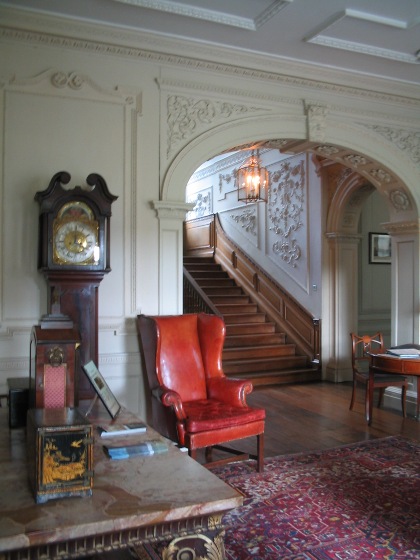
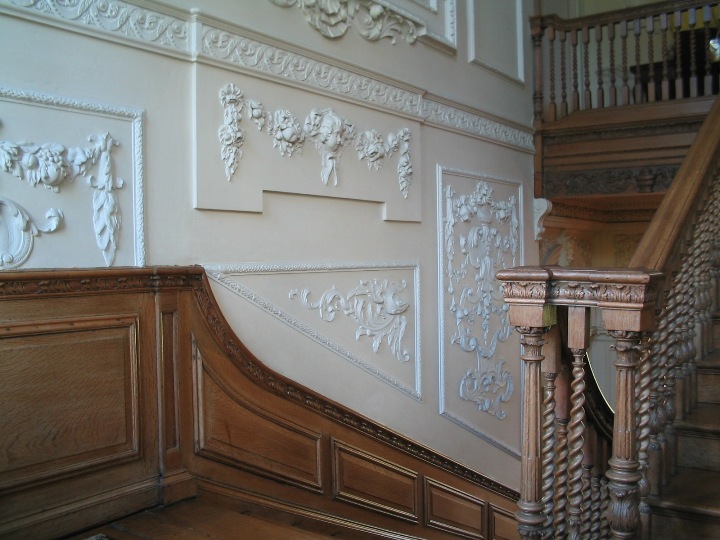
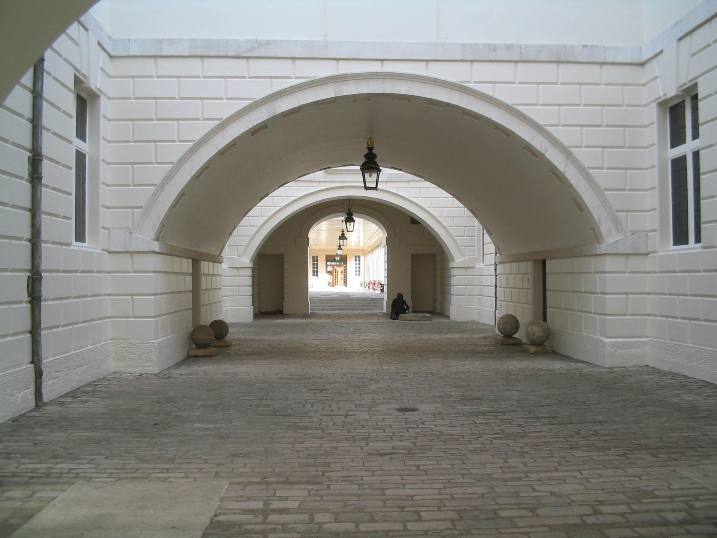

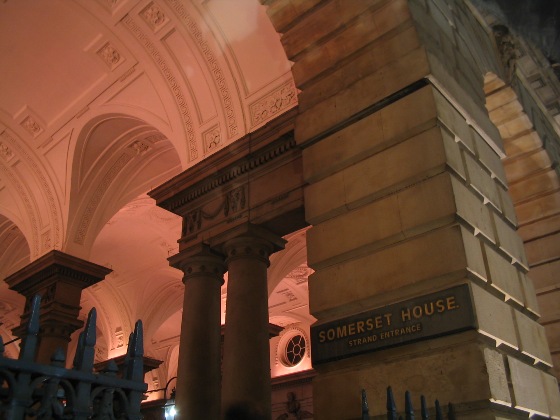
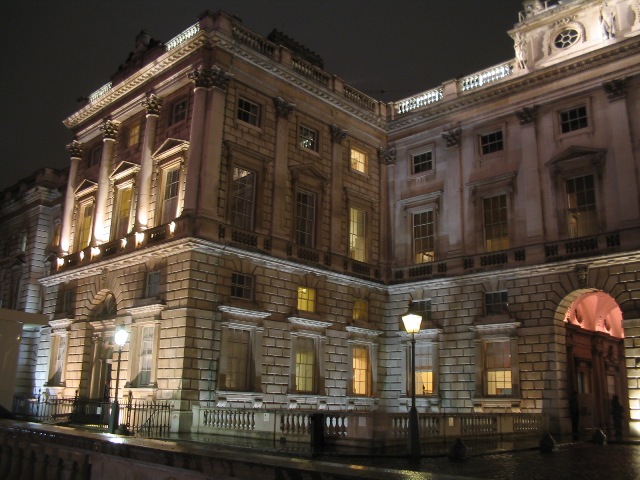
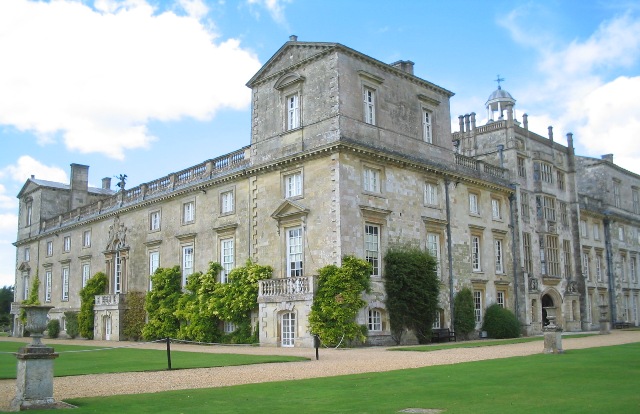
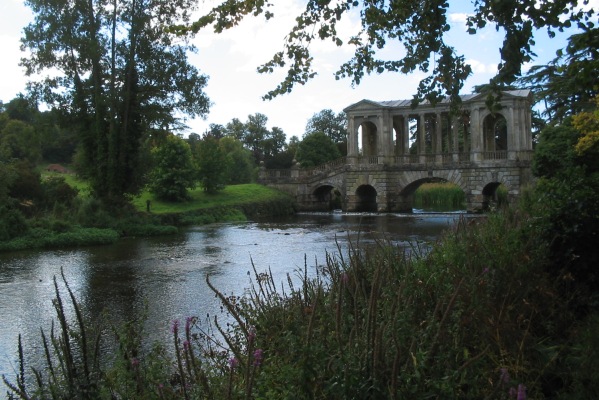
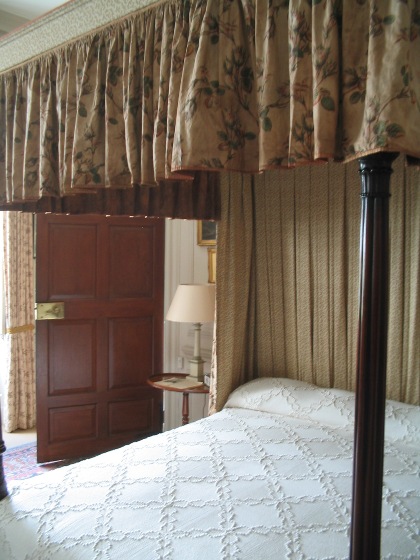
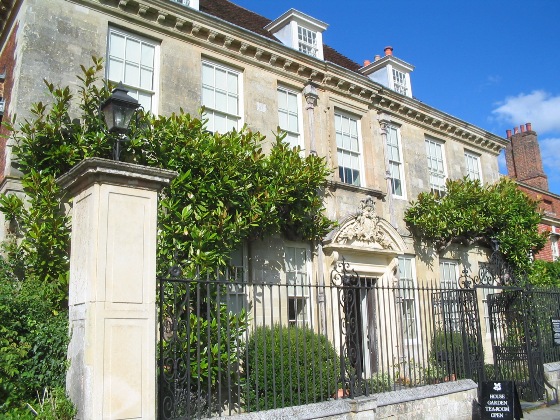
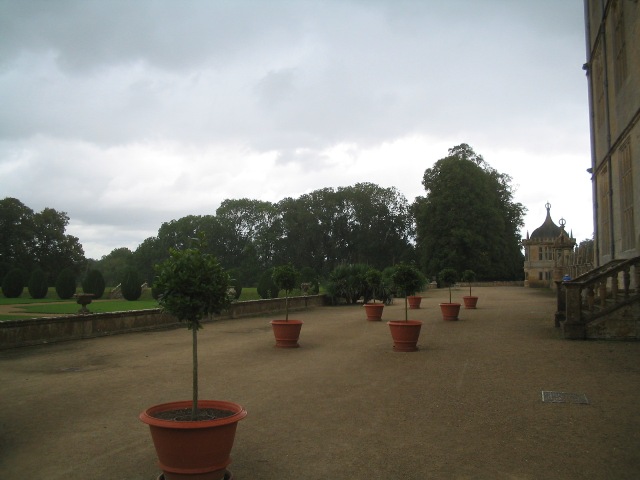
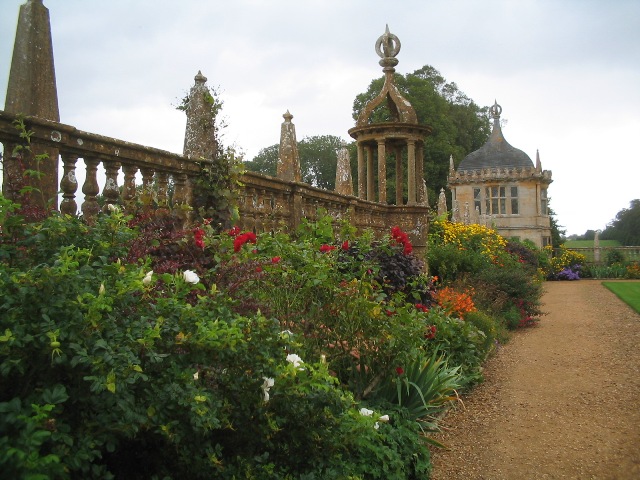
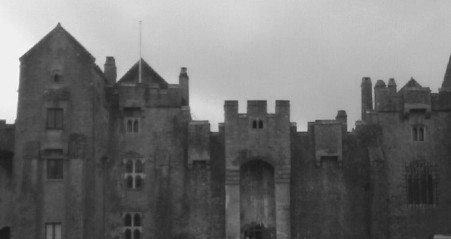
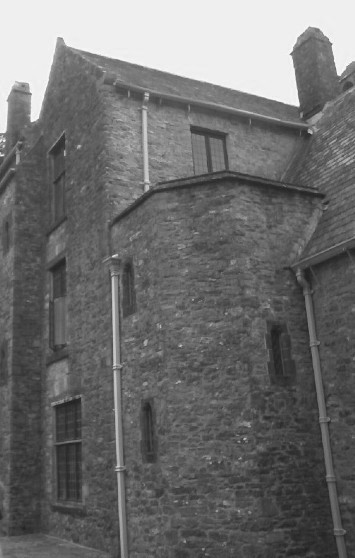
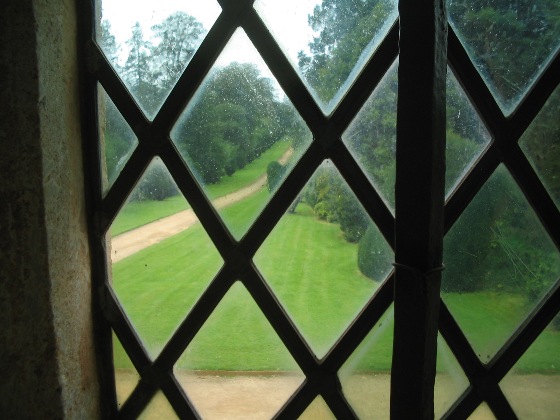
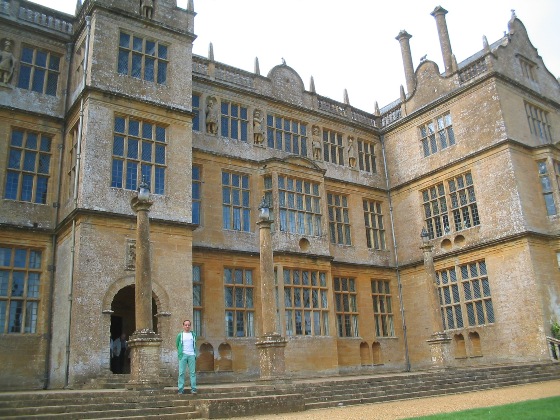
Roman,
To be honest, even though I studied English Literature at uni, but Sense and Sensibility meant nothing to me…I was not a big fan of such things. Recently, I bought a novel called Sense and Sensibility and Monsters and I loved it because it had that weird factor “monsters”. However, looking at your exhibition made me curious to read the actual novel and watch the film again. Your exhibition is truly inspiring. I admire your effort to put all this up together in a “sensible” way. My two favorite were Palladin Bridge and Inigo Jones’s Tulip Staircase. xx
~ Luby
Thanks Luby!
Glad to hear that you liked it. I also love the Tulip Staircase – and of course the Palladian Bridge… Next time you’re in London we should visit the Queen’s House at Greenwich. xx
Admirable work, Roman, you make your mother very proud for your perseverance and devotion to the cause, and your sensitive sensibility concerning your project. Bravo!! Though I hold English literature very high, your exhibition regarding the film S&S made me feel even stronger the grandeur of this country, revealed through its literature, buildings etc.
Thanks mum!
Some of these exterior shots are beautiful Roman, especially the stables and the colonnade, and of course the tulip staircase. Really enjoyed looking through them with the extracts to accompany the images, didnt think I remembered much of the film but was really evocative.
Thanks Julia! Glad you enjoyed it. The Colonnade only appears very briefly in the film but it’s fascinating how much effort and preparation they put into recreating the era/market for a scene lasting a few seconds. Saltram was amazing – definitely worth visiting if you haven’t already been there.
This is awesome, Roman! Really impressed with your approach. Love the Tulip Staircase and great hall 🙂
🙂 Thanks Einar! Glad you liked it. I have to admit it’s not the most innovative, dynamic or interactive way of telling stories – but I still haven’t found an interface that would work for this genre so I decided to keep it simple. The great hall is amazing – btw, if you stare at the centre of the circle for a while you start to think that the photo’s borders are curved!
While not a huge fan of S&S and that period, the beauty and charm of so many of these photos is undeniable! I wish I’d seen them before I returned from my time in the U.K. earlier this year. I particularly love the reverse angles of The Colonnade and Queen’s House, the whimsy of The Plym Estuary photo, and the amazing colors and contrast in the The Great Hall at Montacute photo. You’ve definitely piqued my interest, and I’ll be looking out for the movie the next time it plays on TV. Simply amazing work!
That’s great to hear, thanks so much Sarah! Btw, I was lucky enough to get ‘clear shots’ of the Colonnade and the Great Hall at the Queen’s House, avoiding the steady trickle of people passing through.
congratulations Roman on this project!
I really enjoyed every single photo you’ve posted. It’s amazing how much efford they put into in order to recreate this era…. xxx
Thank you Catherine! xx
many thanks, Roman. Fascinating. So long since I read the novel that i’ve completely forgotten the plot, and for some reason I never saw the film. Films of Jane Austen are often very annoying, but it looks as though this one might be an exception. Ang Lee & Emma Thompson is certainly a promising combination.
Perhaps you should persuade ET to do an interview, filmed in some of these locations, which could then be included on DVDs of the film? Anyway, I hope you send her this – I’m sure she’d be flattered, as Michael Frayn was by your treatment of Afterlife.
Thanks so much Edward, that’s very kind of you.
I’m afraid I don’t have Emma Thompson’s contact details – but, as always, thank you for the encouraging feedback.
Beautiful photos, Roman! I’ll have to see the film again…
Thank you Laura!
Lovely exhibition Roman – really nice way of exploring a film text.
Thanks so much Jim!
Amazing work! Well done to a great and meticulous story-teller! 🙂
🙂 xx
Roman this is really great, to be able to view the different properties from different points of view – both physically and with the movie dialog for placement! I am a huge fan of these types of films because of the grand manors and palatial backdrops and grounds used in the settings! I do hope you will do the same for Pride and Prejudice! I am across the pond in Texas and will not be going across to that side of the world, so I am much enthralled with your beautiful work! I wish to thank ya kindly~
Carol, thanks so much for your kind comments – glad you enjoyed the photo-essay 🙂
This is a wonderful project! I have watched the film more than half a dozen times, with particular attention to the architecture and interiors, which were so cleverly executed. Although I recognized a few, including the incomparable Wilton House, now I will watch again with even better understanding and appreciation. Next trip, Salisbury revisited, so as to see Mompesson! Thank you!
Lynne, glad you enjoyed the photo-essay and many thanks for the kind comments! R.
Thank you for compiling all these exquisite locations for us to review and remember. The reason I stopped by is because I have been searching diligently ever since the movie came out for the chiming clock that was in the London home of Mrs. Jennings. The characters of Emma Thompson and Kate Winslet were staying there when Hugh Grant’s character came to visit. Surprisingly, Lucy stopped by which threw everything off. But it’s that dainty chiming of the mantel clock that I have been searching for decades. Do you know where I can turn to help track down the manufacturer or similar clock used specifically for that scene? Thank you so much!